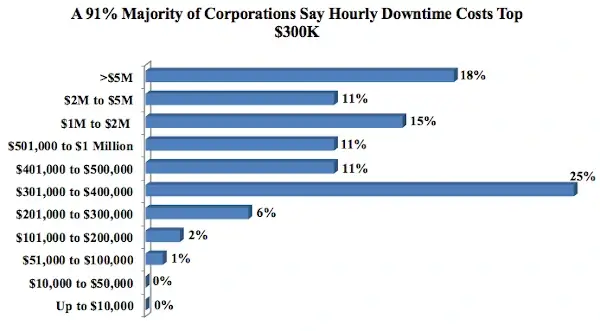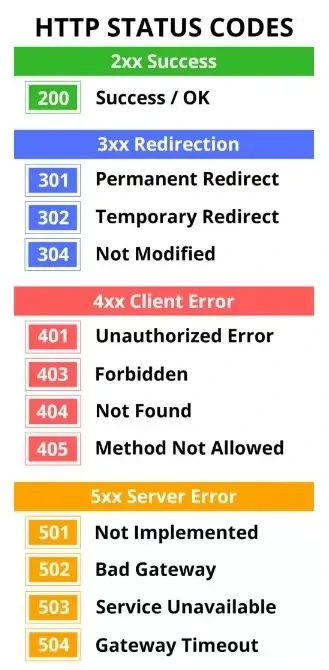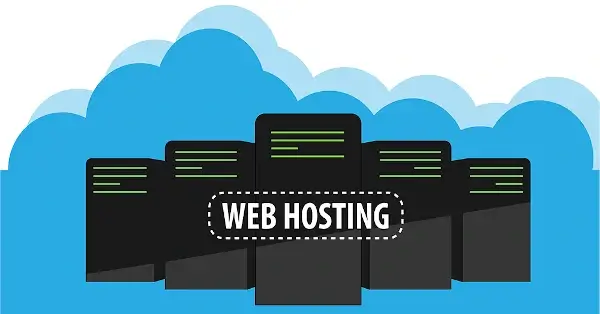
Given the advanced digital age we are in now, a website's uptime and availability determine the success of businesses of all shapes and sizes. There are numerous challenges that each organization must face and overcome to ensure business continuity. One of the top on this list of challenges is website downtime.
Your website must always be up so visitors can access it anytime and anywhere. However, if your website is frequently down, it will be tagged as unreliable, which reflects poorly on you. Hence, website downtime is disruptive and unacceptable in today's highly-competitive business landscape. The consequences of website downtime can be disastrous and costly to online businesses; the impact varies depending on many factors.
It is always regrettable and more costly having to fire-fight. The longer your website is down, the more money you lose; this is every business owner's worst nightmare. However, many are still unaware of how deadly a website downtime can be to any business.
Take heart. Knowing about website downtime helps to formulate a pragmatic plan to mitigate the impact. Also, understanding the performance metrics helps bring about more effective monitoring before matters get out of hand.
What is Website Downtime?
Website downtime is when the website cannot function properly or is inaccessible; this falls into a wide range of issues that usually are performance and functionality related. Generally speaking, downtimes can either be planned or unplanned. You won't dread the former as much because this happens on a planned schedule.
You are in the driver's seat and have control. Planned downtimes usually occur during off-peak times. There's usually an alternative you afford your users during this scheduled downtime. However, unplanned downtime happens unexpectedly and is much dreaded as it can be costly and harmful to your business.
While a planned downtime is usually for website maintenance, unplanned downtime is due to many reasons:
- Server failure - you may have outgrown your web hosting, and your server cannot keep up with higher demands.
- Obsolete hardware - outdated hardware sacrifices performance.
- Hardware misconfiguration - wrong settings sacrifice performance and create security loopholes.
- Outdated software - unpatched and outdated applications cause inefficiencies and allow security attacks.
- Human error - whether accidental or not, simple acts of an employee deleting critical data or not following standard security protocols can cause downtime.
- Cybersecurity attacks - hackers are always on the prowl; they look to wreak havoc on websites through DDoS attacks, DNS cache poisoning, ransomware and phishing attacks, and others.
- Natural disasters - hurricanes, tornadoes, floods, and earthquakes are among the few that can disrupt the power supply, communication and damage hardware.
Website Downtime Costs and Impact
Website downtime (whether planned or not) has its share of costs and impact. The difference is to what extent they impact the company. Here are several website downtime impacts that all business owners must know:

Website downtime costs vary depending on the duration, business size, nature, and more. In 2021, 25% of global respondents reported that the average hourly downtime cost hit between $301,000 and $400,000; these are whopping figures seeing that they are hourly rates.
Calculating the cost of downtime is not straightforward, as there are several factors in the equation. Although there are downtime cost calculators that you can use to help evaluate the downtime impact on your business, you can choose to calculate the downtime cost instead.
Downtime cost = duration x cost/minute (depends on the size of your business)
The downtime cost computed this way is more of a guesstimate as the cost/minute is an estimated figure. However, if you have difficulty identifying your cost/minute, look towards calculating the cost impact in terms of loss in productivity.
Productivity cost = impacted number of employees x hourly rate
Both equations confirm that time is a critical factor in determining your business's eventual revenue loss.
Brand Perception Suffers
In these fast-paced times, where people expect speedy responses and seamless website experience, delays are intolerable, and downtime is highly unacceptable. Imagine a first-time visitor landing on your website and find it inaccessible. Your website is perceived to be unreliable and dubious with negative connotations.
Visitors will never return as they can look elsewhere for a more efficient website experience. Regardless of the downtime duration (whether short or long), they have seen you at a 'bad' time. As such, this brands your business with a negative impression.
People will talk. They will share and spread this unfortunate incident with others. A rippling effect occurs, turning into waves resulting in bad reviews and a tarnished brand image. Recovering your brand image becomes an uphill battle.
The same applies if your website is hacked. You then realize that you don't even have the basic security in place, that is, Secure Socket Layer (SSL), to encrypt your communications. It is never too late to ask the "What is OpenSSL" question, so you will know how to implement one to secure your website.
Missed Business Opportunities
Every industry is competitive. You have many others who sell the same as you. Hence, you invest in building a website to function as your 24/7 sales agent to leverage today's interconnected digital world. What happens when this 24/7 sales agent becomes out of action? You lose out on lucrative business deals with others.
Not only do you fail to attract new customers, but you also risk upsetting and losing your existing ones. People's patience runs thinly. They won't wait more than two seconds for your website to load. The slower your website becomes, the more people will bounce off your website. Downtime(s) drive people away.
Productivity Loss
When downtime occurs, mission-critical systems usually become unavailable. While some teams will be busy trying to get things back up, other teams will not be able to resume their work. Hence, these employees become involuntarily idle.
For example, an entire production line in the manufacturing sector cannot run due to an outage. Not only do the employees sit around and do nothing, but disruption to supply chains occurs, and backlogs pile up.
Since you lose out on business opportunities, you have less income but still, have to pay the labor and operating costs. Depending on the duration of the downtime, larger businesses may feel the pinch; what more the smaller ones.
SLA Pay-Outs
Businesses have Service Level Agreements (SLAs) with their customers. Your customers seek a certain level of guarantee that they will get what they have paid for within an agreed time or have access to products/services at all times. Using an SLA uptime calculator helps you define and communicate acceptable downtime thresholds, reinforcing trust and accountability.
Imagine the catastrophe level when your system becomes unavailable due to downtime, which impacts all your vendors. They cannot do business and will file claims against you.
For example, you are a payment service provider, but your system is unavailable. As such, the merchants who have registered with you will have suffered losses because their customers cannot make payments; their customers will take their business elsewhere. The merchants will then seek financial remuneration from you, which can sink your business in time.
Critical Data Loss
Downtime can cause corrupted, damaged, and lost data. And if you don't have a reliable backup, you can kiss goodbye to your business. Or if you do have a backup on the Cloud, it can take some time to reach your data, especially if access to the Cloud is lost. Although this is only temporary, it suffices to create panic among your customers.
Also, unplanned downtimes can expose your critical data or create security gaps. Hackers will have a field day. Regaining your customers' trust becomes a neverending uphill battle.
SEO Damage

Once your website is live, Google indexes your website. GoogleBot crawls your website to collect relevant information to add to Google's search engine. If your website is down, GoogleBot will find an error code instead; this can negatively impact your ranking in the Search Engine Results Pages (SERPs).
If your downtime is only brief, the impact is minimal. However, if the duration extends endlessly or is frequently down, Google will label your website as unreliable, which drops your ranking. Restoring your position becomes more difficult with every downtime and its extension.
Google recommends altering your website's response status code to a 503 error explaining that the outage is only temporary instead of showing a 404 response code, meaning your website is 'not found.' GoogleBot will deem your website temporarily down upon seeing a 503 error and will not heavily penalize your rankings.
Website Downtime Best Solutions
You now know that a website's uptime is critical for the survival of any business. However, downtimes are unpredictable and unavoidable. They can happen anytime and usually when you least expect them. Don't worry, as there are ways to reduce and minimize the impact of downtimes on your business:
Monitor and Prevention
Be proactive and diligently monitor your applications' metrics and servers' health. Prevention is better than cure. Firefighting is not a long-term solution, nor a good solution. You must know what is happening beforehand to take the necessary steps promptly before any issues get out of hand.
Being in the dark is the last thing you want. You want a solution to help monitor everything about your network, servers, web pages, transactions, devices, and others to gain valuable insights to help detect any potential failures or leaks. Additionally, you need to identify the performance metrics for more effective monitoring.
Proactive monitoring helps identify potential problems fast to avoid any downtime or disruption to services. It also involves performing a factual post-mortem after the downtime episode to identify the root failure so you can take the relevant measures to rectify the situation so that it will not happen again.
Pro Tip! Ensure your business e-mails work properly so you can get alerted in case of downtime.
Create a Business Continuity and Disaster Recovery Plan
Every business must have a Business Continuity and Disaster Recovery (BCDR) strategy. Many believe that it is a waste of time to draft one. However, should a disaster occur, you will be thankful you invested the time to create a Business Continuity and Disaster Recovery plan.
A comprehensive BCDR plan prepares and steers you for unforeseen downtimes. You won't panic and be at a loss because you will know what to do during downtime. You can also recover quickly and continue to provide services to your customers. Hence, take some time to craft a reliable BCDR plan.
Check Your Web Hosting

It is better to have more than less; this applies to your servers and their resources. However, a realistic approach is to balance this with the cost factor. Many times, downtime is due to an overloaded server, or you have outgrown your web hosting. Yes, your web hosting affords you the uptime and performance you need.
Hence, look into your web hosting solution and check if it can cater to your growing needs. While starters are satisfied with shared hosting, many opt for a Virtual Private Server (VPS) as it allows you to scale up when necessary. Also, VPS is affordable. You can consider DDoS-protected VPS for added security.
Conduct Regular Load Tests
Aka volume testing, load testing is perhaps an often overlooked task. Many are unaware of the number of users (concurrent or not) their website can take before an issue happens. However, you need to understand the maximum traffic your website can withstand before breaking down. Assuming you know your expected daily traffic, you will then make the necessary rectifications to equip your systems better for uninterrupted service.
Hence, the importance of load testing; these test your website's performance under a specific load. With regular load testing, you can determine how your service behaves under different conditions. You can then locate potential bottlenecks in your systems to understand their vulnerabilities. Then you can take the proactive approach to resolve any issues before they blow up.
Educate Employees
Human error is possibly one of the most common causes of downtime. Many feign ignorance as the reason. However, it is every employee's responsibility to know how to safeguard their company's valuable data. Whether intentional or not, the effect of such human errors is the same - equally disastrous.
It is also the responsibility of employers to train and educate their employees on security best practices - the dos and don'ts. Employees will then have no excuse to use ignorance to justify their misdeeds. They need to know the emerging cyber threats, including malware, ransomware, phishing attacks, and others. Also, they must strictly adhere to standard policies and procedures. To further mitigate the risk of human error, incorporating effective employee management software can serve as a proactive measure, offering tools for continuous training, real-time updates on security protocols, and business communication solutions for quick communication among team members.
Final Thoughts
Website downtime is no joke. It can potentially paralyze your business and bring about irreparable damage. Aside from financial losses, other repercussions of downtime prevail, resulting in undesirable consequences when unprepared.
That said, you can do something about this and minimize the cost and impact of downtime on your business. Knowing the cost and impact of downtimes is critical to taking steps toward mitigating them and reducing any damaging ripple effects on your company.
X


 Copyright 2000-2026, WebSitePulse. All rights reserved.
Copyright 2000-2026, WebSitePulse. All rights reserved.